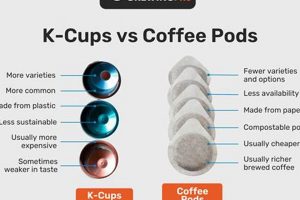A frequently asked question among coffee drinkers centers on the yield of a standard one-pound bag of coffee beans. The answer depends on several factors, primarily the brewing method and the desired strength of the beverage. Generally, a pound of roasted coffee beans contains enough ground coffee to produce a significant number of brewed cups.
Understanding the yield from a pound of coffee is valuable for both budgeting and reducing waste. Knowing how much coffee is typically extracted from a pound allows consumers to plan their purchases more effectively and minimize unused coffee grounds. This also relates to consistency; knowing how many cups result from each pound allows for a more controlled brewing process, leading to more predictable and satisfying results.
This article will delve into the specifics determining coffee yield, examining the influence of grind size, brewing method, and preferred strength. It will provide a comprehensive overview to help estimate the number of servings derived from a pound of coffee beans, promoting informed and efficient coffee consumption.
Tips for Maximizing Coffee Yield from a Pound
Optimizing coffee yield from each pound requires understanding key brewing variables and practicing consistent techniques. These tips provide guidance for maximizing the number of servings obtained.
Tip 1: Grind Size Selection: Choose the correct grind size corresponding to the brewing method. A coarse grind is suitable for French presses, while a fine grind is optimal for espresso machines. Incorrect grind size leads to over- or under-extraction, affecting yield and taste.
Tip 2: Precise Measurement: Utilize a scale to measure coffee grounds accurately. A standard ratio is two tablespoons of ground coffee per six ounces of water. Consistent measurement ensures predictable results and prevents overuse of coffee.
Tip 3: Water Temperature Control: Maintain water temperature between 195F and 205F (90C to 96C) for optimal extraction. Overly hot water can scorch the grounds, resulting in a bitter taste and potentially reducing overall yield due to poor flavor necessitating disposal of a portion.
Tip 4: Optimize Brewing Time: Adhere to recommended brewing times for each method. French presses require four minutes of steeping, while drip machines operate automatically. Deviating from these times impacts flavor and efficiency.
Tip 5: Storage Practices: Store coffee beans in an airtight container, away from light, heat, and moisture. Proper storage preserves freshness, preventing the beans from losing flavor or becoming stale, which can lead to using more coffee for the same taste intensity.
Tip 6: Regular Cleaning: Clean the coffee maker regularly to remove mineral deposits and residue. Buildup can affect the brewing process, leading to inconsistent extraction and reduced yield.
Tip 7: Use Filtered Water: Employ filtered water to eliminate impurities that can interfere with coffee flavor. Clean water enhances the brewing process and allows the coffee’s true flavor to shine through, reducing the need to use excessive amounts to achieve desired taste.
Consistently applying these tips ensures efficient use of each pound of coffee, maximizing both flavor and the total number of cups brewed.
The following sections will explore the mathematical calculations behind estimated coffee yields and address potential variations based on different bean types and roast levels.
1. Brewing Method
The choice of brewing method exerts a profound influence on the yield obtained from a pound of coffee. Different methods demand varying coffee-to-water ratios, directly affecting the total number of cups produced. Drip coffee makers, for example, typically use a relatively low ratio, requiring less coffee per cup compared to methods like the French press. This translates to a higher cup yield from the same quantity of coffee beans. Conversely, espresso machines, employing a highly concentrated extraction, necessitate a substantial amount of coffee grounds for each small shot. Therefore, a pound of coffee will yield significantly fewer espresso shots than drip coffee cups. Immersion methods like the French press require more coffee grounds to steep properly and extract flavor effectively.
Consider the practical implications: a coffee shop primarily serving drip coffee will replenish its bean supply less frequently than one specializing in espresso-based beverages. A household using a French press daily will consume coffee at a faster rate than one using a drip machine, given equal cup consumption. A cold brew method requires a large amount of coffee to steep overnight, leading to a smaller total yield for the same one pound of beans.
In summary, the brewing method serves as a primary determinant of coffee yield. Understanding the coffee-to-water ratio specific to each method is essential for accurately estimating the number of cups produced from a pound of coffee and managing coffee consumption effectively. Variations in the method’s efficiency in extraction can influence the overall result, which makes it a crucial factor to consider.
2. Grind Coarseness
Grind coarseness directly influences the extraction rate of coffee solubles and, consequently, the efficiency with which a pound of coffee is utilized. A finer grind exposes a greater surface area to the brewing water, promoting more rapid and complete extraction. This increased extraction efficiency, however, can lead to over-extraction if the brewing time is not appropriately adjusted. Over-extraction results in a bitter, undesirable taste, potentially rendering a portion of the brew unusable and effectively reducing the usable cup yield from the original pound. Conversely, a coarser grind provides less surface area, resulting in under-extraction. Under-extracted coffee tastes sour and weak, again necessitating more coffee grounds to achieve a palatable beverage, thereby lowering the total cup count obtainable from a pound. For example, using a fine espresso grind in a French press will over-extract, creating bitter coffee, while using a coarse French press grind in an espresso machine will under-extract, creating a sour shot. The optimal grind setting, therefore, is method-dependent and crucial for maximizing both flavor and yield.
The selection of grind coarseness interacts with the brewing time. A longer brewing time necessitates a coarser grind to prevent over-extraction, while a shorter brewing time benefits from a finer grind to promote adequate extraction. Consider drip coffee machines, which typically employ a medium grind due to their moderate brewing time. Modifying the grind size significantly without adjusting the machine’s parameters will lead to suboptimal results, reducing the number of satisfactory cups. Similarly, adjusting grind without calibrating your technique, such as tamp pressure and distribution, in espresso preparation impacts the effective yield. Therefore, consistent matching of grind size to brewing time optimizes the balance between extraction efficiency and beverage quality, ultimately affecting how many cups are produced per pound.
In conclusion, grind coarseness serves as a critical control variable in the coffee brewing process, acting as a direct determinant of the overall yield from a given quantity of coffee. Maintaining a grind size appropriate for the selected brewing method ensures efficient extraction, minimizes waste resulting from over- or under-extraction, and maximizes the number of palatable cups produced from a single pound of coffee. Understanding the interplay between grind size, brewing time, and brewing method is essential for achieving both consistent flavor and economical coffee consumption. Improper management of grind size can negate any other efforts to maximize yield, highlighting its paramount importance.
3. Desired Strength
The correlation between the preferred strength of brewed coffee and the yield derived from a pound of coffee beans is direct and inversely proportional. A preference for stronger coffee necessitates a higher coffee-to-water ratio during brewing. This increased concentration of coffee grounds per unit of water results in fewer cups produced from a fixed amount of coffee. Conversely, a preference for weaker coffee allows for a lower coffee-to-water ratio, extending the number of cups obtainable from the same pound. An individual who routinely brews coffee at a ratio of 1:15 (coffee to water) will extract significantly more cups than someone who consistently brews at a ratio of 1:10, given an identical pound of coffee beans. A person who favors an intense, concentrated brew might use a double shot of espresso (approximately 14-20 grams of coffee) where another would use a single shot (7-10 grams), thereby halving the total number of potential servings from a pound for the stronger preference.
Several factors contribute to an individual’s desired coffee strength, including personal taste preferences, habitual caffeine intake, and the intended purpose of the beverage. Someone seeking a significant caffeine boost to improve alertness will likely opt for a stronger brew, consuming more coffee grounds per cup. Conversely, an individual who enjoys the flavor of coffee but seeks to minimize caffeine intake may prefer a weaker concoction. Cultural norms also influence desired strength. In some regions, it is common to consume small, intensely strong cups of coffee, while in others, large, weaker cups are preferred. These societal preferences, in turn, impact the overall yield obtained from a pound of coffee at a community level. Understanding the intended use of the brewed coffee provides insights into how much ground coffee will be needed.
In conclusion, the impact of desired strength on coffee yield is substantial. Individuals and establishments must consider their preferred strength when estimating coffee consumption and budgeting for bean purchases. By accurately assessing the coffee-to-water ratio that satisfies their taste preferences and caffeine needs, consumers can optimize their use of coffee beans, minimizing waste and maximizing the number of enjoyable cups brewed from each pound. While many can have a general idea of “how many cups is a pound of coffee” the consideration of desired strength can make the answer more accurate.
4. Bean Density
Bean density, a physical property inherent to coffee beans, influences the number of cups obtainable from a fixed weight. Denser beans often yield a different grind profile and extraction rate compared to less dense beans, thus impacting the overall brewing efficiency and resulting cup yield. The impact of bean density is not always immediately apparent, but it is a critical factor when considering the economic and practical aspects of coffee consumption.
- Impact on Grind Size
Denser beans tend to be more brittle and may require a finer grind to achieve optimal extraction. A finer grind, while potentially increasing extraction yield, also necessitates careful monitoring to prevent over-extraction, which can lead to bitterness and necessitate the disposal of portions of the brew. The need for a finer grind, while common with denser beans, can shorten the extraction time, potentially affecting the yield in specific brewing methods.
- Water Absorption Rate
Denser beans typically have a lower water absorption rate compared to less dense beans. This difference can influence the overall extraction efficiency, as water penetration is a crucial step in dissolving coffee solubles. A slower water absorption rate may require adjustments to the brewing time or water temperature to ensure adequate extraction, ultimately impacting the yield.
- Roast Level Considerations
Roast level influences bean density. As beans roast, they lose moisture and increase in volume, which changes their density. Lighter roasts tend to retain more density than darker roasts. This means a pound of lighter roast beans may contain more individual beans compared to a pound of darker roast, potentially yielding a higher number of cups if brewed with similar ratios. The changes in density also contribute to how easily the beans grind. Therefore, a roast level that optimizes the density characteristics for the desired brewing method can contribute to an enhanced yield.
- Influence on Extraction Efficiency
Denser beans often contain a higher concentration of desirable compounds, such as sugars and acids, which contribute to the flavor profile. Efficiently extracting these compounds is crucial for maximizing the value of the beans. If the brewing process fails to adequately extract these compounds, it may require more coffee to achieve the desired flavor intensity, effectively reducing the number of cups produced. Proper grinder burr calibration will improve the consistency of the ground coffee and improve extraction efficiency.
In summary, bean density plays a crucial role in determining “how many cups is a pound of coffee”. Understanding the properties of the beans, including their density and how it influences grind size, water absorption, and extraction efficiency, allows for informed adjustments to the brewing process. These adjustments ensure optimal flavor extraction and help maximize the number of cups derived from a pound of coffee beans, highlighting the importance of bean density in both economic and qualitative aspects of coffee preparation.
5. Measurement Accuracy
Measurement accuracy exerts a profound influence on the yield obtained from a pound of coffee. Precise measurement, both of the coffee grounds and the brewing water, is critical for achieving consistent and predictable brewing outcomes. Deviations from recommended ratios, even seemingly minor ones, can accumulate over time, significantly altering the total number of cups produced from a single pound. Inaccurate measurement constitutes a significant source of variability and waste, undermining efforts to optimize coffee consumption.
The impact of measurement accuracy manifests in several ways. Overestimation of coffee grounds leads to excessive consumption, reducing the number of cups. Conversely, underestimation results in weaker coffee, often prompting users to add more coffee grounds, also diminishing the yield. For example, consistently adding a “slightly rounded” scoop of coffee instead of a level scoop can accumulate to a significant quantity over a month, resulting in premature depletion of the coffee supply. Similarly, estimating water volume rather than using a measuring cup can lead to similar inconsistencies. Accurate measurement using calibrated scales and measuring devices minimizes these variations and fosters consistent extraction, optimizing the coffee-to-water ratio for maximum yield and flavor quality. In commercial settings, neglecting accurate measurement can significantly impact profitability, leading to increased costs and reduced customer satisfaction due to inconsistent beverage quality.
In summary, measurement accuracy forms a cornerstone of efficient coffee brewing, directly impacting the number of cups derived from each pound of coffee. By adopting precise measurement practices, consumers and businesses can achieve greater consistency, reduce waste, and optimize coffee consumption. While other factors contribute to the overall yield, measurement accuracy remains a fundamental element that underpins all efforts to maximize the value obtained from each pound of coffee beans. Consistently using precise tools like a digital scale eliminates guesswork and enables reliable replication of optimal brewing parameters, leading to a stable extraction and total yield.
Frequently Asked Questions
This section addresses common inquiries regarding the number of cups obtainable from a standard pound of coffee beans, providing clarity on factors influencing yield.
Question 1: Does roast level significantly alter the cup yield?
Roast level influences bean density. Lighter roasts generally retain more mass and density than darker roasts due to less moisture loss during roasting. Therefore, a pound of light roast beans might contain more individual beans, potentially yielding more cups if brewed with similar ratios, compared to a pound of darker roast.
Question 2: How does grind size affect the total number of cups I can brew?
Grind size significantly impacts extraction efficiency. Finer grinds offer more surface area, potentially extracting more coffee solubles, but risking over-extraction and bitterness. Coarser grinds may lead to under-extraction and weak coffee. Optimal grind size, matched to the brewing method, maximizes flavor and yield.
Question 3: Is using a scale really necessary for measuring coffee?
A scale ensures accurate measurement, crucial for consistent brewing. Volume-based measurements, such as scoops, are less precise and can lead to variations in coffee-to-water ratios, impacting both flavor and the overall number of cups derived from a pound.
Question 4: Can the type of coffee beans affect the cup yield?
Bean density varies between different coffee bean types (e.g., Arabica vs. Robusta). Denser beans might require adjustments in grind size or brewing parameters to optimize extraction. The composition of the bean and ratio of solubles affect the taste, but can affect how much coffee is used to reach desired quality level and thus the number of cups.
Question 5: How does water quality influence the extraction and yield from a pound of coffee?
Water quality significantly impacts coffee flavor. Impurities or excessive minerals can interfere with the extraction process. Filtered water provides a cleaner base, allowing the coffee’s true flavors to emerge, potentially requiring less coffee to achieve the desired taste and extending yield.
Question 6: Does using a paper filter versus a metal filter influence the yield from a pound of coffee?
The type of filter affects the body and clarity of the coffee. Paper filters trap oils, resulting in a cleaner cup, while metal filters allow oils to pass through, resulting in a richer, heavier body. While the perceived quality and flavor profile might influence brewing habits, the actual extraction and subsequent yield from a pound are not directly affected.
Accurate estimation of coffee yield requires considering various factors, including roast level, grind size, measurement precision, bean type, water quality, and brewing method. Optimizing each element will enhance both flavor and the total number of cups obtained from each pound of coffee.
The next section will provide a concluding summary, reinforcing the key principles for efficient coffee consumption and highlighting the long-term benefits of informed brewing practices.
Conclusion
The preceding exploration underscores the complexity of determining precisely “how many cups is a pound of coffee.” The answer is not a static figure, but rather a variable outcome influenced by a confluence of brewing parameters, bean characteristics, and user preferences. Methodical attention to grind size, brewing technique, water quality, and desired strength is paramount in optimizing yield. Furthermore, bean density and roast level introduce nuanced considerations that impact the efficiency of extraction and the overall number of cups produced.
Adopting informed and conscientious brewing practices allows for both economic and gustatory benefits. By diligently controlling variables and understanding their interconnected effects, consumers and commercial establishments can minimize waste, maximize flavor, and achieve a consistently satisfying coffee experience. Continued refinement of brewing techniques ensures efficient and sustainable coffee consumption, promoting both personal enjoyment and responsible resource management.







